Ceiling in the kitchen: original finishes
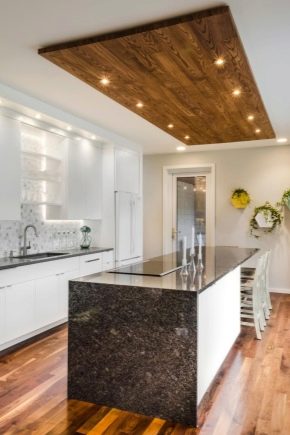
When starting to decorate the ceiling in the kitchen when renovating or buying an apartment, many do not know what material to choose for this. There are many different options on the construction market that at first glance will look great in any room. In fact, not every coating has the properties that are suitable for this particular room.
In addition, the ceiling should be related in style to the rest of the interior of the room, harmoniously combined with it. In order to choose the right material, you need to know the advantages and disadvantages of each of them, as well as the main features of a standard kitchen in an apartment or private house.
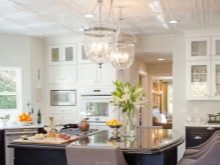
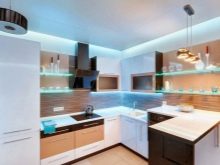
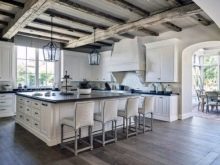
Material requirements
Unlike a bedroom or a living room, a kitchen is a room with its own special microclimate. There is always something to cook, roast and bake in it. Because of this, the humidity level is always high here, hot steam rises to the ceiling and affects its finish. To remove food odors and reduce the temperature in the room, windows are often opened or the hood is turned on, which also has a certain effect on the finishing materials.
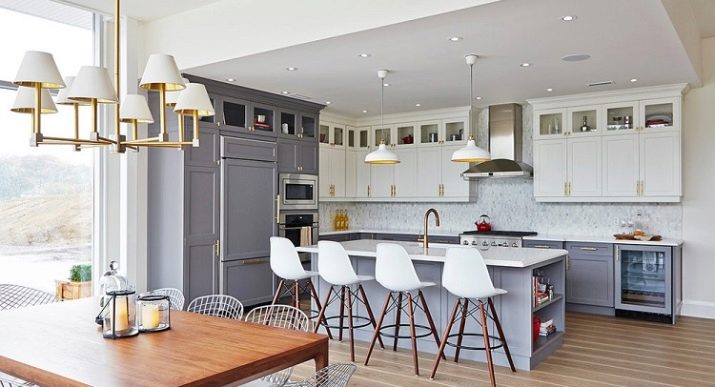
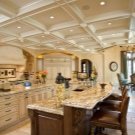
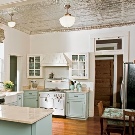
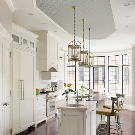

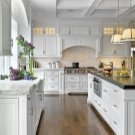
All this formed a certain list of requirements for finishing not only the walls and floors, but also the kitchen ceiling.
- Moisture resistance. The coating must be able to withstand constant contact with humid air and hot steam. In cases where this requirement was not taken into account when purchasing, the ceiling may "swell", voids and wet spots will appear in it.
- Wear resistance. As food is cooked every day, the ceiling is constantly attacked. Even the strongest material in this room wears out and deteriorates many times faster than in the living room or hallway. In order not to start new repairs after a couple of years, it is necessary to make the ceiling from the most wear-resistant material that can be purchased.
- Hygiene and ease of use. No matter how neat the owners and hostesses are, not a single person can cook in perfect cleanliness for years. After creating some culinary masterpieces, splashes of grease and other liquids can even be found on the chandelier. And constantly rising vapors leave unsightly dark spots. Ceiling decoration should allow easy wet cleaning without the use of aggressive cleaning agents, or be resistant to their effects. At the same time, the material must also be resistant to the formation and effects of various mold or mildew, since in rooms with high humidity these microorganisms are frequent guests.
- Non-flammability. A fire in an apartment is one of the main nightmares of any owner and tenant. In order to minimize the risk of fire, it is necessary to choose the least combustible materials for interior decoration. This is especially true for the renovation of the kitchen, since there is a source of open fire in this room, and a large number of various electrical appliances.
Compliance with these requirements will increase the comfort and safety of any kitchen, as well as keep the renovation fresh for much longer, without requiring constant adjustments.
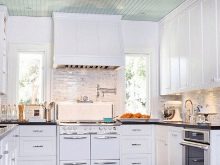
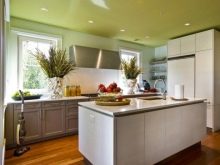
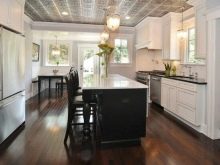
Finishing types
Kitchen renovations, as in other rooms, are carried out from top to bottom. Therefore, before choosing a wall covering or furniture design, you need to decide on the design of the ceiling. All modern finishing methods can be conditionally subdivided into budget and expensive ones. The former include whitewashing, painting and wallpaper. And to the second - plasterboard structures, plastic panels and a slatted ceiling, as well as stretch canvases.
You can decorate the kitchen in any of the following ways, since all of them have their pros and cons. However, in each specific situation, one or more options may be preferable to the others.
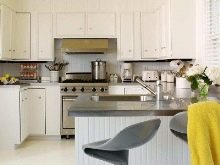
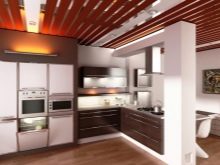

Whitewashing or painting
One of the simplest and cheapest options for finishing a kitchen ceiling is regular paint or whitewash. This option was common in almost every Soviet apartment and is still quite popular. Despite the similarity of works, these materials are somewhat different and have their own advantages and disadvantages.
Whitewash
In addition to the low cost and ease of application, among the advantages of this type of finish, one can also note high environmental friendliness and vapor permeability. Streams of hot, humid air pass practically through the bleached ceiling. However, with excessive vaporization, ugly dark spots may remain on the whitewash, so it is worth choosing a quality manufacturer and observing the application technology. Another plus is that with this method of finishing the ceiling, the room does not lose its height, as when installing complex frame structures. Of the minuses, it is possible to note rapid wear (within 3-5 years), a small selection of decor and difficulty in care.
Chalk and lime whitewash is almost impossible to wash, since it is destroyed by contact with water.
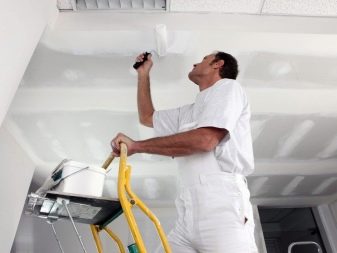
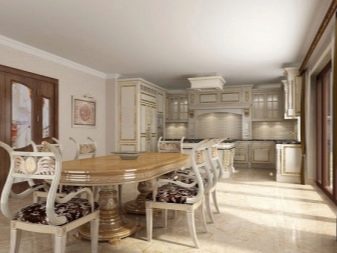
Painting
Like whitewashing, the paint is quite environmentally friendly, has a low price and does not change the height of the ceiling. Moreover, the complexity of such work on a flat surface is even lower than that of working with chalk or lime. Unfortunately, in order to achieve this level surface, you will have to carry out a lot of preparation of the ceiling, plastering and priming it. It is also not recommended to wash such a ceiling with a large amount of water or cleaning agents, although it will tolerate a damp cloth without consequences. The service life of such a ceiling is very short and ranges from 3 to 10 years maximum. It depends on what kind of paint and what quality was applied. Water-based and acrylic paints are most susceptible to wear. Latex, silicate and silicone coatings have a longer service life.

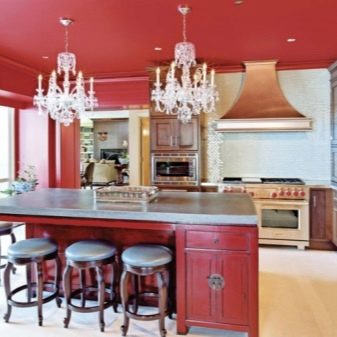
Wallpaper
There is a misconception that ceiling wallpaper is an outdated and tasteless finish and can only be found in old village houses. In fact, modern materials offer a wide variety of not only qualities, but also textures, designs and colors. There are so beautiful interiors using this finishing option that many do not even realize that it is literally made of paper. In addition to beauty, the advantages of wallpaper include their low cost, ease of installation and dismantling, as well as high sound insulation compared to whitewashing and painting.
The main disadvantages are short service life (no more than 5 years), fear of direct sunlight and poor moisture and steam tolerance. In addition, many buyers complain about the poor antistatic properties of this coating. The paper on the ceiling absorbs odors and collects a lot of dust. Non-woven fabric, unlike ordinary ceiling wallpaper, copes with this perfectly, but such material has a negative effect on human health. Like whitewash paint, wallpapering a kitchen ceiling requires pre-leveling the surface, which is also a very laborious process.
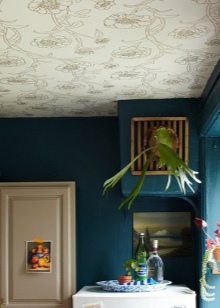

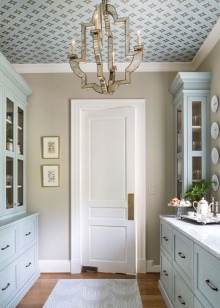
Drywall
Many owners of both city apartments and country houses prefer to make suspended ceilings from plasterboard. Indeed, the advantages and characteristics of such a material make it, in some cases, simply irreplaceable. This method of finishing does not require preliminary leveling and processing of the ceiling, its installation is so simple that even a beginner can handle it. With the help of drywall, you can hide any structures and communications located above, for example, ceiling beams in a private house or ventilation pipes and wiring in an apartment.
With plasterboard, it is easy to make complex multi-level ceilings with rounded shapes and curves and a large variety of fixtures. This building material allows you to additionally insulate and soundproof the room.
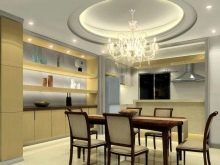
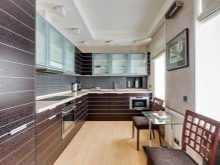
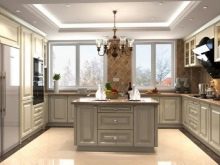
Among the disadvantages of drywall, it is possible to note the need for the installation of a special construction tool, which is very expensive. It is almost impossible to carry out such an installation alone. Due to the profile, even the simplest finishing option will "eat" at least 5 centimeters of ceiling height.
In addition, cracks and breaks often appear at the joints of gypsum plasterboard sheets after a couple of years of operation, so it is necessary to carefully choose the manufacturer and carry out its installation in compliance with all instructions.
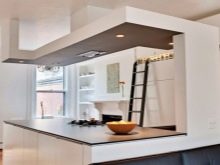
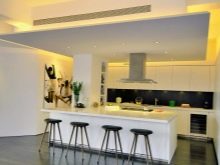
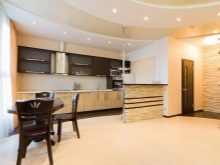
Plastic panels
Over the past decade, PVC ceiling panels have not lost their popularity. Of course, they are most often used when decorating the ceiling in the bathroom, but this option can also be found in many kitchens. The main, but not the only advantage of this material is its low cost. In addition, plastic is very hygienic, does not emit any substances and is easily treated with detergents from dirt and microorganisms. High moisture resistance and durability allow it to retain its attractive appearance for a long time after repair.
Plastic retains heat well and absorbs sounds, and the installation of such panels is easy to carry out alone and does not require a special expensive tool and long preliminary preparation of the ceiling. A rich assortment of sizes, shapes and designs makes it easy to choose an option for any interior. Such panels can imitate various materials, for example, natural wood, stone or even a mirror surface.
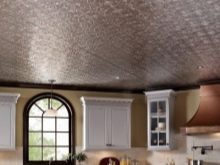
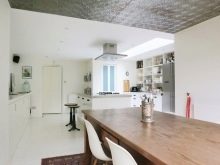
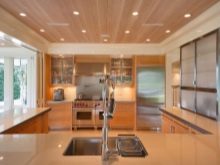
Unfortunately, like any other material, PVC panels are not without certain disadvantages. The main one is flammability. Worst of all, when the plastic burns, it releases a large amount of poisonous gas that is dangerous to humans. In addition, thin panels are very susceptible to mechanical damage and can crack and even fly apart from a pinpoint impact.
Plastic tends to lose its brightness in direct sunlight. When finishing with plastic, you will definitely have to buy and install a ceiling molding or baseboard in order to hide the not always even and neat junction of the panel with the wall.
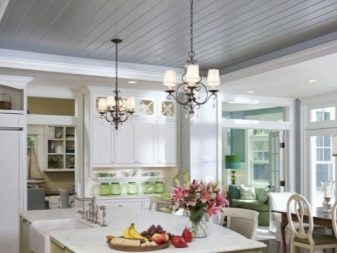

Lining
Natural wood is a very high quality, but very expensive material for decoration. Not every family can afford to make a wooden ceiling in the kitchen. In this case, the lining slatted ceiling is an excellent alternative. The profiled board is durable and reliable, it is almost as environmentally friendly as wood in the solid wood, and much more environmentally friendly than plastic or drywall. Sheathing the ceiling with clapboard is quite simple even alone, the procedure does not require special knowledge and expensive tools. Such a finish will help hide minor flaws in rough repairs and some communications. In addition, wood in the interior is always very aesthetically pleasing and soundly.
Unfortunately, there are also significant drawbacks to this finish. For example, this is the high flammability of wood. However, you can slightly reduce the risks by treating the yards with special protective flame retardants.Another significant disadvantage is the need for preliminary installation of a frame made of wooden beams, which will "eat" a few centimeters of the height of the room.
Improper care or too much moisture leads to deformation and swelling of the lining, it begins to pop out of the grooves and creak.
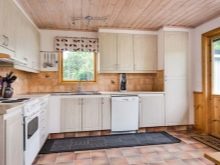
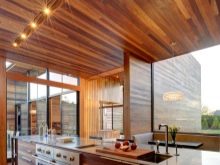
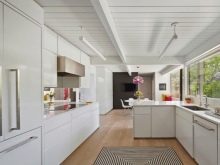
Tension
The newest type of ceiling decoration is a stretch canvas. Its most important advantage, which is often of the greatest importance, is its high aesthetics. Matte and glossy, variegated and monochromatic, single-level and combined - the masters will make and install absolutely any option at the request of the buyer. On such a ceiling, not a single seam is visible, it does not collect dust and does not require special maintenance. With such a ceiling, a flood from the neighbors from above is not terrible; it will fill with water like a bubble and keep it inside itself. The average service life of the stretching fabric is 5 to 10 years.
The main disadvantage of such a finish is the impossibility of doing it yourself. You need industrial printing equipment for drawing, as well as a special heat gun to heat and stretch the web. But even with all the necessary tools, without training and experience, it is quite difficult to do such work with your own hands. Another disadvantage of stretch ceilings is their low environmental friendliness. Such a coating does not "breathe", and therefore creates the so-called greenhouse effect. At a fairly high cost, the canvas is completely fragile and cannot be repaired. Therefore, it will be impossible to wash and even more so to rub such a ceiling.

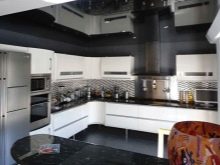
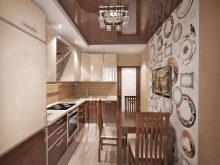
Other options
Another, once popular, and now practically uncommon option is expanded polystyrene tiles. Once she could be found in almost any apartment. The rich stucco molding of an almost weightless material adorned the joints of the ceiling and walls, and the square itself was divided into neat pastel squares. Its only advantage was its very low price. This non-breathable, toxic when burning and unaesthetic material is used less and less and almost never in kitchens today. Over time, it will be completely replaced by better, albeit slightly more expensive, plastic or drywall.
Ceiling decoration with plaster alone is becoming more and more popular. Unlike old materials, modern plaster looks just as good as paint or whitewash. There are textured plasters that create a rough surface with small or large indentations. This option can be suitable for a loft or country kitchen. Occasionally there are very unusual ceiling designs. It can be tile or stone, mirrored panels or stained-glass windows, and even weaving from vines or dry reeds. The main thing is that such a kitchen meets the requirements of fire safety and pleases its owners not only with beauty, but also with reliability.
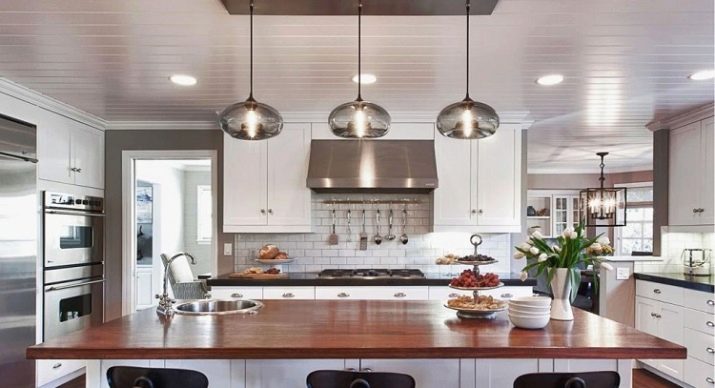
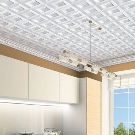

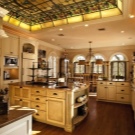
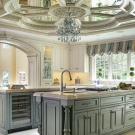
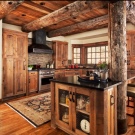
Features of choice
Having familiarized yourself with all possible finishing materials, having studied their pros and cons, you can start choosing a specific option. In order to prevent an annoying miss, it is worth paying special attention to the following nuances.
- Price. First of all, you should decide on the budget. Even choosing a simple ceiling wallpaper, you can purchase an inexpensive domestic version, or you can order goods from a foreign manufacturer with a worldwide reputation.
- Compliance with the requirements. Materials must be fireproof and environmentally friendly, tolerate high humidity and temperature extremes well, be strong and durable.
- Installation conditions. It is best to choose materials based on the expected amount of preparatory work. For example, if the surface of the ceiling is too uneven, communication pipes run along it, you should choose drywall, lining or stretch canvas.This will make it possible to do without a lot of labor and time in trying to get the ideal horizontal line required for ink or paper.
- Operating conditions. Some families cook daily and in large quantities, while others prefer to eat out. Therefore, only moisture-resistant and hygienic coatings are suitable for the first family, and the second family can choose any option that is attractive to them externally.
- Harmonious combination. Before buying building materials, it is worth considering the entire interior design. The whole room should be made in the same style, combined in colors and textures. A mirrored ceiling will look strange in a country setting, and the soft smooth lines of a two-level stretch ceiling will not match classic-style furniture and wallpaper.
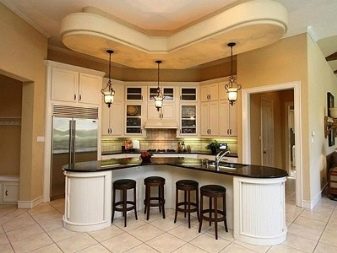
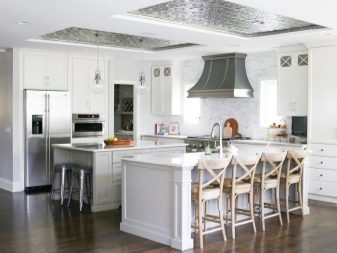
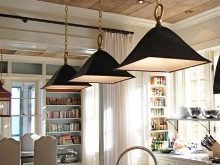
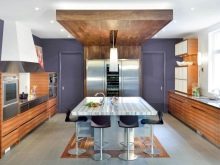
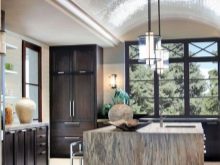
Original design ideas
For every kitchen, you can find the perfect ceiling design that will hide the mistakes of the designers and highlight the obvious advantages. So, for example, for a kitchen that has both a cooking area and a food intake area, multi-level plasterboard structures are perfect. They will separate them not only by their height, but also by light sources mounted along the contours or in the centers.

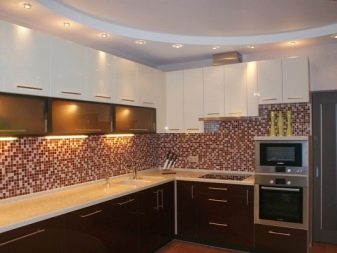
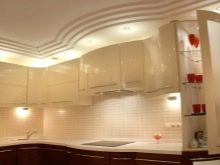
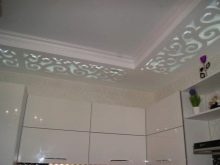
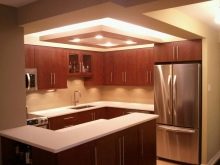
For an interior in a Scandinavian or country style, natural wood trim is perfect. In the event that such material is too expensive, you can place plastic false beams on the ceiling, which, even upon close examination, practically do not differ from the real ones.
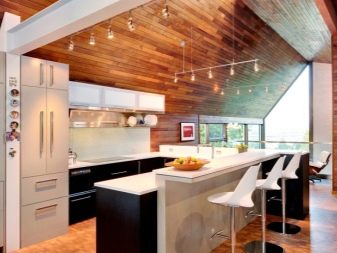
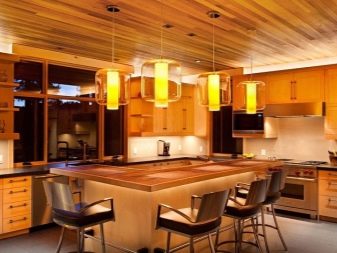
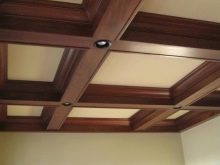
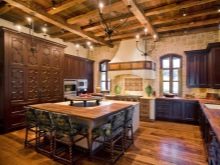

A large spacious kitchen will be emphasized by unusual stretch ceilings with photo printing. It can be either an abstract drawing or a whole picture with a plot. And for small kitchens, glossy and mirrored slatted surfaces are perfect. Through reflection, they visually expand the space and make the kitchen look taller.
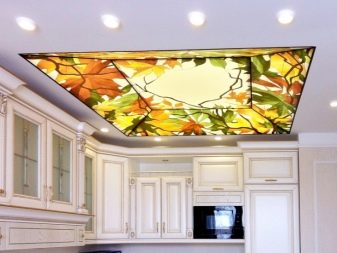
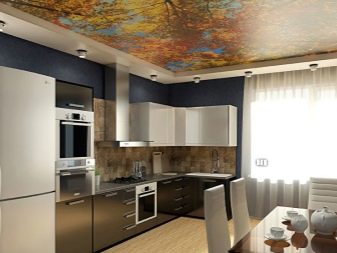
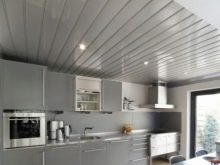
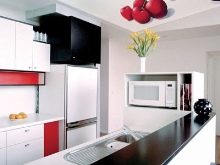
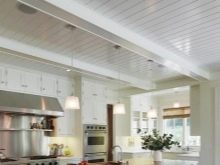
The simple and laconic design of the walls and floor goes well with the complex combined design of the ceiling. It can be a combination of contrasting colors or different materials. However, you do not need to combine more than two types of finishes at the same time, this will overload the ceiling and ruin the initially excellent idea.
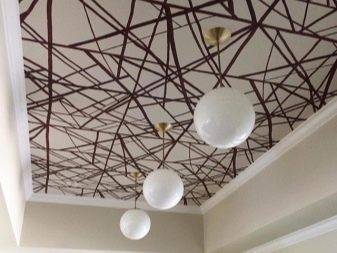

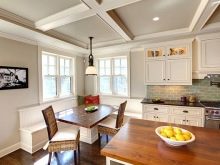
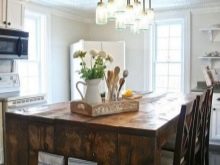
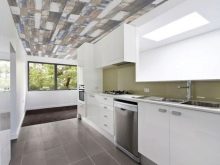
In the next video, you will find the installation and finishing of a two-level gypsum plasterboard ceiling structure in the kitchen.










The comment was sent successfully.